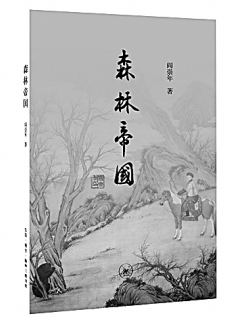Analyzing Chinese history based on forest culture

Forest Empire
Yan Chongnian is a research fellow from the Institute of Manchu Studies at the Beijing Academy of Social Sciences. His recent book on the history of the Qing Dynasty has an interesting name “Forest Empire.” In this work, he not only illustrates the rise and fall of the Qing Dynasty, but also establishes a history of forest culture. He gives a general history of the regions of northeastern China where the forest plays a significant role in local history. It covers 3,000 years ranging from the Sushen tribes in the pre-Qin period to the Manchu in the Qing Dynasty.
Using this historical concept of forest culture, Yan gives a general picture of the ethnic development in the past 3,000 years in the forest cultural zone in northeastern China. He illustrates details of the Sushen people in the Shang and Zhou dynasties, the Yilou people in the Qin and Han dynasties and the Wuji people in the Wei and Jin dynasties. And, then, after evolution for over 2,000 years, the Mohe people established the Balhae Kingdom in the Tang Dynasty. Yan considered the reign of the Liao people as a cultural transition period, and the Jin Kingdom established by Jurchen as the first forest culture that successfully entered the Central Plains of China and occupied half the territory of China.
After that, during the Ming Dynasty, the Jurchen people in the Jianzhou area expanded and their leader Nurhachi established the Later Jin regime and his son, Huang Taiji, also known as the Taizong Emperor, then changed the name of this kingdom to the Great Qing in 1636. This forest culture united other cultural modalities and peoples. In 1644, when the Ming Dynasty fell apart, he led his troops marching into the Central Plains of China. By the year 1755 when the government office of the General of Yili was established, this forest empire reached its pinnacle. However, for a long time, this empire was unable to tackle its relationship with the farming culture of the Han people. In addition, it also faced clashes with Western capitalist culture. Eventually, it declined and collapsed.
The producers in forest culture were different from those of other cultures. They must coordinate and cooperate when hunting. Weilie or hewei, meaning hunting by encircling, was characterized by cooperation. The Eight Banners system of the Later Jin and the Qing Dynasty, which later became military-administrative organizations, originated from “hewei.” Therefore, “he,” which means cooperation, uniting or integration, was a distinctive element of forest culture. Furthermore, Yan suggests that cultural integration provides tremendous momentum for historical progression—this was the secret of how the Manchu people could unite China and maintain their dominion for centuries.
(edited by CHEN ALONG)
